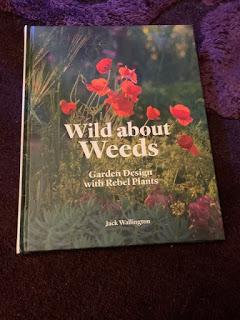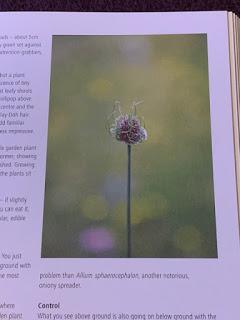I have met Jack Wallington a couple of times and quite often cross paths on Twitter. When I saw that he had written a book apparently about weeds I decided I would buy it. I was pretty sure that this book was going to worth reading.

The joy of pre-ordering a book is that is arrives almost out of the blue. It was a happy surprise parcel when I got home from work on a dark autumn evening. I have spent some time reading the book and whilst I was under no obligation to write about it, when has that ever stopped me?
This is a book about weeds and whilst it does spend a little time telling you how to deal with some pernicious weeds, but this is not a book about weeding or, really, about weeds. For what is a weed? Jack gets pretty quickly to this question as it does define the trajectory of the book. I think many of us embrace the notion that a weed is a plant in the wrong place; Jack references this but goes on further and ends with a definition "a plant that reproduces seemingly uncontrollably". As I got further into the book I could see that this was a good definition. Not all weeds are wildflowers, not all wildflowers are weeds and of course as we all know, some ornamental plants when introduced into foreign environments can become a weed (yes Japanese Knotweed, I do mean you). Jack takes us through a history of weeds, about the weeds we 'like' and the ones that we demonise.

It feels countintuitive to have a section about bringing weeds into your garden, but I could only smile and recognise that I have done exactly this on so many occasions. At a previous garden I bought some lawn daisy plugs to put into the lawn. A lawn without daisies just was not for me. I now grow teasles, they are superb plants but I am sure every seed germinates. Jack talks about bringing various weeds you might wish to have in your garden. He talks about Herb Robert, please do contact me if you want some as I have a lot and I cannot bear the smell of it.
This is a book that as you wander through it will raise emotions such as mine about Herb Robert. Why would anyone want it I muse? Then I look at the section on Ragwort which I allow to grow in my Wild Garden. I did not plant it there, but it grows and caterpillars love it. It is poisonous for horses but they are not something I need to consider in my urban garden. For me it is a rebel plant, for others a definite hazard.
Jack thankfully has a section on managing rebel plants and some do take some managing!

I planted Allium vineale in my garden some years ago and I mismanaged it to begin with. It nearly took over, but now I keep it more controlled I have begun to almost like it again.....
What I saw as the heart of the book though is where Jack starts to talk about 'nature's design and plant communities' and then takes us through 'Weeds for every situation'. This section is very detailed with profiles of different weeds that like different conditions. Some weeds will thrive and seed everywhere in a particular situation but may be more manageable in others. There is a neat table of characteristics for each featured weed that includes plant family, size, flowering period, situation etc.
I really like this book and I know I will re-read it. I think I took more to the notion of 'rebel plants' than to calling them weeds; but it is a good hook to make you pick the book up. The book is about the beauty of plants irrespective of how we might wish to classify them. This is very neatly summed up in the very last sentance in the book (yes I am one of those sad people who reads a book to the very last word). On page 176 the Acknowledgements end with: "Finally, this book is dedicated to everyone who sees beauty in all forms of life". Fitting last words.
Wild about Weeds by Jack Wallington is published by Laurence King Publishing and is available from places that sell books. Buy it for someone for Christmas and they will thank you and make sure that you either drop large hints to family and friends or buy one for yourself.

